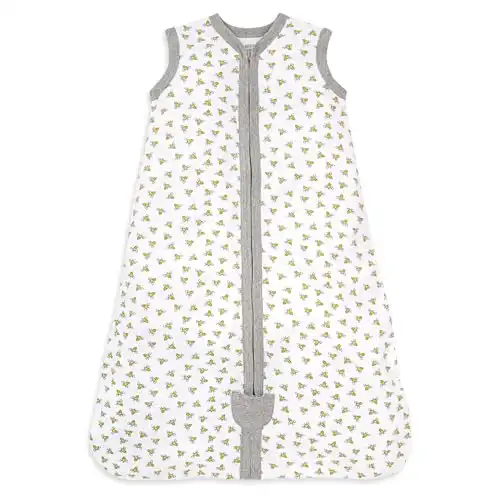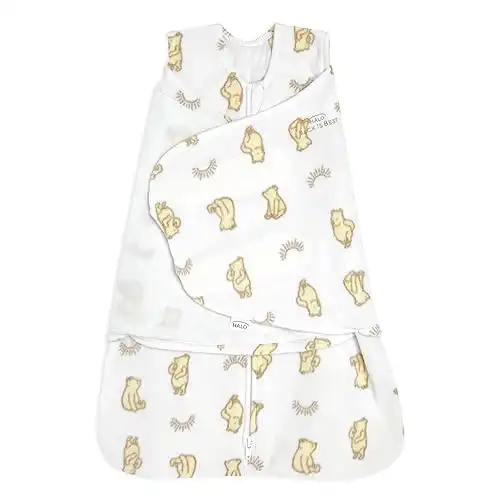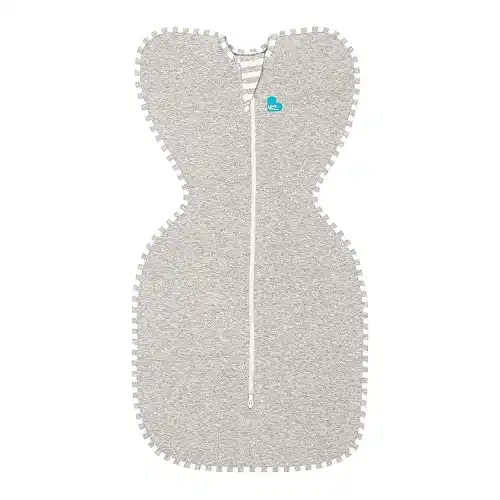Newborns look so cozy and cuddly when they’re safely wrapped up in a swaddle… but now they’re breaking free from their wrap and getting restless when trying to sleep.
Not only is this frustrating for you… but it is dangerous for baby. Therefore, we must make a change.
Fortunatley, there is plenty you can do to help stop your baby breaking out of swaddle and there are many solutions for when swaddling is no longer the best option for your little one.
In today’s article, I will share over 40 years of childcare experience with you, so you can make an informed decision about how to help your ‘Houdini Baby’ to sleep deeply, soundly, and safely!
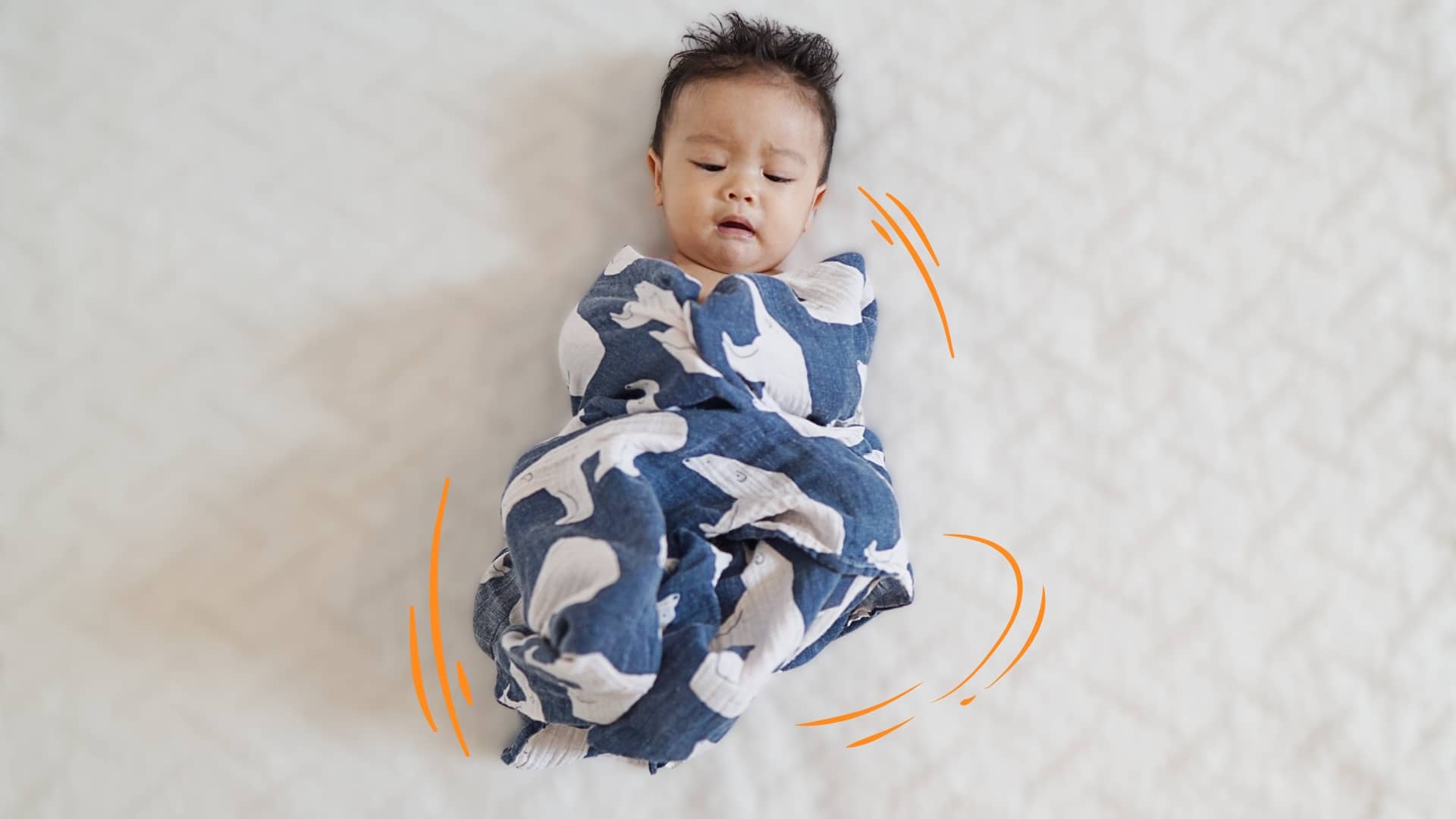
Table of Contents
Why Does Baby Break Out Of Swaddle?
In my many years of experience, I have witnessed many babies breaking out of their swaddle during sleep. And whilst some swaddle breaks are OK… some breaks will require an adjustment from you. Here’s why they happen:
- The swaddle is too loose: Learning how to swaddle your baby can be tricky and if you don’t get it right you may find that your little one is constantly breaking free because the wrap is not properly secured.
- It’s time for baby to transition: Young babies are very happy in their swaddle, but as they grow, your baby may want to have their arms free and will struggle and wiggle to get free.
- Baby doesn’t like the feel: Not all babies like to be swaddled and do not like being restricted. This will result in baby fussing and trying to break out of their swaddle.
- Baby just wants to move: If your little one likes to kick and wriggle around then a swaddle will probably not be for them. Their desire for movement will result in them trying to break free, no matter how well-wrapped the swaddle is. You’ll also find your baby gets frustrated and finds it hard to settle because they’re not able to move.
- They’re too warm: If your baby is too warm in their swaddle their face will flush, their neck will be warm, and their back will be sweating. Your baby’s wriggling and fussiness indicate they wish to break out to cool themselves down.
Some of these swaddling issues can be resolved by adjusting the type of swaddle or swaddling method you use… However, other issues stem from your baby not liking being swaddled and you will, therefore, need another sleeping solution.
Whatever the case, your baby’s comfort and safety during sleep must be paramount.
So here’s what you must do when your baby breaks out of their swaddle.
What You MUST Do If Baby Keeps Breaking Free From The Swaddle
When your baby continually tries to escape the swaddle, it’s a sure sign you need to reassess your technique or swaddling option.
- If baby is still content to wear a swaddle, a snug fit is key… but don’t restrict your baby’s ability to breathe comfortably or move their legs. It is also important not to pin your baby’s arms too tightly to their sides. A good rule of thumb to follow is: If there is just enough room to fit two fingers of space between their chest and the swaddle then the baby is swaddled correctly.
- If your baby shows signs of discomfort or rolling, consider upgrading baby to a transition swaddle that allows your baby to have their arms free when they’re ready. If your baby starts rolling, swaddle with one or both arms out to prevent them from rolling over in their sleep and to promote motor development.
- If your baby has a larger frame, consider using a sleep sack or ensure that you have the correct size blanket when swaddling them to ensure the wrapped blanket does not fall apart in the night.
|
5.0
|
5.0
|
5.0
|
|
|
|
- Promotes a snug and secure feeling
- Great design with an interior zipper guard
- Simplifies diaper changes with bottom opening zipper
- Machine washable on a cold wash and gentle tumble dry
- Large variety of sizes and tog weights
- 100% cotton - perfect for soft sensitive skin
- Customizable swaddling options to help your baby transition from swaddle to sleeping sack
- Bottom zipper for convenient diaper changes
- Recognized as "Hip Healthy" by the International Hip Dysplasia Institute
- Supports baby's self-soothing by allowing arms up position
- Swift diaper changes due to two-way zipper design
- Recognized by the International Hip Dysplasia Institute
- Comes in different tog weights
REMEMBER: The period of time when swaddling is most effective is relatively short and that transitioning from swaddling is a step towards greater independence. Patience is essential as you and your baby find what works best. If your baby really dislikes the swaddle then don’t force them to wear one.
Looking to get your little one to sleep quickly and effortlessly? Check out my Bedtime and Nap Cheat Sheet and master the art of making daytime naps and bedtimes as seamless as possible.
A bedtime & nap cheat sheet so good your little one will ask you to put them to bed...
Laura Williams "This is a life saver! I'm so glad I downloaded your bedtime & nap cheat sheet. My little one actually asked me to put him to bed last night! Unbelievable! Thank you so much!"
Click Here For The FREE Cheat Sheet
How To Properly Wrap Baby In A Swaddle
When swaddling your newborn, choosing the correct size blanket is vital. It should be at least 44 inches square to ensure a snug wrap without being too tight.
Also, opt for a lightweight and breathable material like muslin or bamboo to keep your baby comfortable.
Looking for the perfect swaddle for your little one? Look no further than these Comfy Cubs Muslin Swaddle Blankets! Made from ultra-soft, breathable muslin cotton, these swaddles are gentle on your baby's delicate skin and he generous 47x47 inch size provides ample space for snug wrapping, ensuring your baby feels secure and comfortable.
With a variety of adorable patterns, these swaddles are not only functional but also stylish. They are versatile and can be used as receiving blankets, nursing covers, or stroller covers. Easy to wash and maintain, they are a must-have for any new parent!
Steps To Swaddle Your Baby To Stop Break Outs:
- Lay the blanket in a diamond shape and fold the top corner down. This creates a straight edge at the top.
- Place your baby face-up on the blanket, aligning their neck with the top edge. Ensure that the baby’s arms are positioned comfortably at their sides.
- Pull the left corner snugly over the baby and tuck it beneath the right side, keeping the baby’s arm secure.
- Repeat on the right side, pulling the fabric over baby’s tummy, and tucking the end under their left side. Avoid wrapping too tight; allow enough room for the baby’s legs to move. Remember there should be just enough room to fit two fingers of space between their chest and the swaddle.
- Consider using Velcro swaddles for a more foolproof method. This prevents the swaddle from coming loose if your baby is a wriggler.
- Keeping arms free: Some babies prefer to have their arms free. If this is the case, wrap their body while leaving the arms outside the swaddle.
Here’s a quick video from Snuggle Hunny to show you how to swaddle a baby with arms in:
Safe Swaddling Rules:
The top safe swaddling rules to abide by are:
- Always ensure the swaddle is not too tight and allows room for hip movement. Always prioritize your infant’s safety and comfort.
- Stop swaddling when your baby shows signs of trying to roll over. This is usually around 2 to 4 months of age.
- Always place a swaddled baby on their back to sleep.
- Watch for signs of overheating such as sweating or fast breathing. And change baby’s attire to suit the sleeping environment. Learn more by reading this post: How To Dress Baby For Sleep
- If swaddling doesn’t work for your baby, it’s fine to stop. There are other ways to promote safe and restful sleep and if required, your pediatrician will be a good source for advice on swaddling and safe sleep practices.
Is Swaddling Still Recommended?
Yes! Swaddling is still a practice endorsed by the American Academy of Pediatrics (AAP) as long as it is accompanied by safe sleep practices such as placing baby to sleep on their back and on a firm sleep surface free from loose objects.
Swaddling can help your baby feel secure and sleep better because the technique mimics the snug environment of a mother’s womb.
Top Benefits of Swaddling:
- Decreased crying
- Reducing the startle reflex
- Longer sleep periods
- Can help calm a baby
- Decreased risk of SIDS (Sudden Infant Death Syndrome)
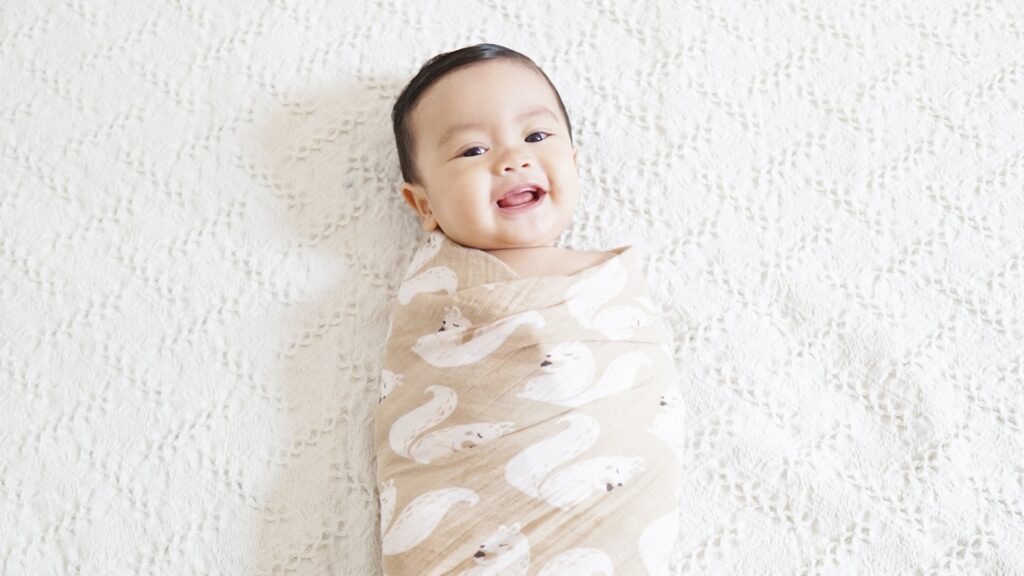
At What Age Should I Stop Swaddling My Baby?
Swaddling is a practice used to help infants sleep soundly by mimicking the snugness of the womb, so it is ideal for newborn babies.
However, as your baby grows, the time will come to transition away from swaddling.
The general recommendation is to stop swaddling when your baby shows signs of being able to roll over. This milestone typically occurs around 2 to 4 months of age.
However, even if your baby is not showing signs of rolling over… many will show signs of wanting more freedom of movement and being ready to transition at around 2-4 months of age.
After stopping the swaddle, it is still important to ensure your baby sleeps on their back.
Learn more about when to stop swaddling by reading this post: When To Stop Swaddling Baby: Safe Sleep Recommendations
How To Transition Baby Out Of Swaddle
If you have decided it’s time to transition your baby out of their swaddle, you must do the following:
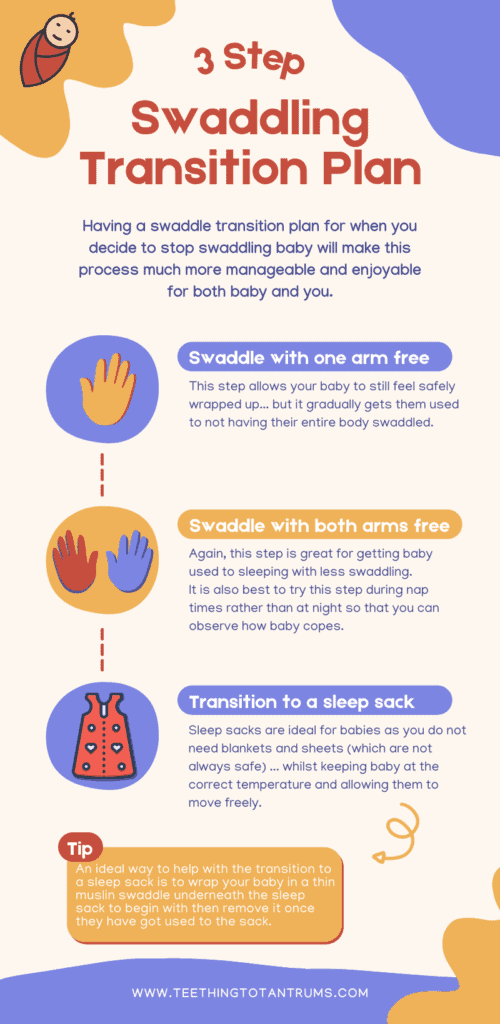
- Start Gradually by Leaving One Arm Out. Begin by continuing to swaddle your baby, but with one arm out for security. This allows your baby to slowly get used to the change without feeling too exposed. Once they get used to this feeling, after a few nights, progress to swaddling with both arms out. This is very important if your baby is showing signs of rolling over.
- Introduce a Transition Swaddle or Sleep Sack. Use products like the ‘The Love to Dream Swaddle’ up or a zip-down sleepsack for this phase. They provide a familiar snugness while giving babies more freedom to kick their legs, wiggle, and move. Some transitional swaddles cater to the need for gradual transition offering various configurations for baby’s arms too. Read this post to learn more: The 4 Best Newborn Sleep Sacks You Need To Try
- Ensure a Consistent Sleep Routine. As always, maintaining a consistent bedtime routine will provide comfort during transitional changes. This is because familiar steps before bed can help your baby feel secure even when their swaddling has changed. A known sequence of activities like a warm bath and a calming story can greatly ease the transition.
- Consider the Cold Turkey Method for Older Infants. For older babies showing signs of wanting more freedom, suddenly stopping swaddling can work wonders. This should be done with caution, however, and only if your baby seems ready (probably over 3 months of age). You can look for signs of frustration with the swaddle or a strong desire to move too.
- Monitor for Hip Dysplasia. Hip health is of paramount importance when swaddling and transitioning. Ensure any transition swaddle you use allows for natural hip movement. Tight swaddling can lead to hip dysplasia, so as you transition, look for products that keep the hips in a healthy position. To learn more about hip dysplasia and how to avoid it, read this: HipDysplasia.Org
Frequently Asked Questions About A Baby Breaking Out Of A Swaddle
The topics below cover common concerns about babies escaping swaddles and the next steps you might consider.
Q: What are the best swaddle techniques for a baby who escapes their swaddle?
A: To keep your baby securely swaddled, ensure the blanket is the right size. A lightweight, breathable blanket that’s at least 44 inches square is ideal. Use a technique that wraps the blanket snugly around your baby without restricting movement too much, offering a balance of security and comfort. Consider using a swaddle sleep sack or transition swaddle.
Q: What are the potential risks of swaddling a baby who can roll over?
A: Babies should be able to roll both ways without the swaddle constraining them. If swaddled, they may not be able to roll back, leading to an increased risk of sudden infant death syndrome (SIDS) or suffocation. Having your baby’s arms free when they are showing signs of swaddling is important.
Q: How can I tell if my baby no longer wants to be swaddled?
A: Your baby might resist the swaddle if they’re ready to stop being swaddled. Signs include fussing, crying when swaddled, or consistently trying to break free from the swaddle. They might also sleep better without the swaddle, which is a clear indication that it’s time for a transition.
Q: What alternatives to swaddling can I use to help my baby sleep?
A: When it’s time to move on from swaddling, consider using a sleep sack, which is a wearable blanket. Other options include swaddling with one arm out or using a transitional swaddle suit designed to mimic the feeling of a swaddle while allowing more freedom of movement. These alternatives can provide the cozy security your baby needs while minimizing risks.
Need More Parenting Help?
- Download our FREE Bedtime & Nap Sleep Cheat Sheet. It’s a free, easy-to-use and proven formula designed for parents of 0-5 year olds to master the art of consistently undisturbed and restful sleep without the yelling, nagging or exhausting long-winded evenings.
- Check out our Parenting Toolbox. You’ll get access to expertly-chosen products that you can guarantee are the best for your little one and your wallet.
- Are you looking for personalized guidance to navigate the challenges of parenting? I offer 1-on-1 consultations to bring you tailored strategies and actionable advice to help support your child's growth and well-being with confidence.

A bedtime & nap cheat sheet so good your little one will ask you to put them to bed...
Laura Williams "This is a life saver! I'm so glad I downloaded your bedtime & nap cheat sheet. My little one actually asked me to put him to bed last night! Unbelievable! Thank you so much!"
Click Here For The FREE Cheat Sheet
